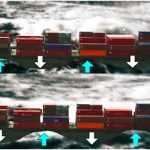1. The presence of a gravity disc in the purifier- There is a general misconception that gravity disc generates the interface between oil and water in the purifier. this is not correct. Interface is formed dude to the centrifuging action, the lighter oil particles will be in the central portion and the heavier water and sludge particles will move to the outer periphery. Thus, What is gravity disc doing here??? NOTHING.! Gravity disc is just giving a surface of separation between oil and water flow. In alfa Laval alcap purifiers which are newer models of the renewed manufacturer, There is no gravity disc present. Instead of gravity disc a water in oil detector is used.
2. Clarifier has a sealing ring which seals the water outlet, as water and impurities remain in the until desludging.
3.The conical discs in a clarifier usually don’t have feed holes in them but if they do, then a disc without any holes is fitted at the bottom of the stack.
4. Sealing water is not present in clarifiers for the generation of a seal that prevents the oil to leave through the water outlet at starting. Purifiers and Clarifiers differ only in that clarifiers are not set up to remove water.
Gangway safeties in ships. Things to be checked before using the gangway.
The accommodation ladder and gangway must:
1. be firmly secured to the bulwark;
2. be properly aligned with the means of access to the vessel;
3. have treads that are at least 600 mm in width and 200 mm in depth, with a permanent non-slip surface;
4. be equipped with two handhold stanchions that are not less than 40 mm in diameter;
5. extend not less than 1.2 m above the top of the bulwark;
6. be fitted at the point of boarding or disembarking the vessel not less than 700 mm and not more than 800 mm apart.
Every accommodation ladder and gangway must:
1. be maintained in a safe condition;
2. be installed in a manner that reduces movement;
3. be suitably rigged and maintained to compensate for the movement of the vessel;
4. be adequately lighted;
5. as far as practicable, be not be more than a 40° angle to the horizontal plane;
6. be provided with a lifebuoy that has an attached line and is strategically placed and ready for immediate use; and
7. have the mechanical, electrical, gearing, hydraulic and pneumatic systems in good working order.
Freeboard explained ,and why it is given
In sailing and boating, free board means the distance from the waterline to the upper deck level, measured at the lowest point of sheer where water can enter the boat or ship

Freeboard defines the reserve buoyancy of a vessel. It is to be there to satisfy the reserve buoyancy regulations by IMO and other conventions. Reserve buoyancy is important for the vessel’s safe operation at sea.
Sufficient free board is required at all times to prevent the vessel being swamped and overwhelmed. For ocean going vessels, it is important to note that those structures above the waterline that are not watertight will not contribute to the reserve buoyancy of the vessel. Again, this makes sense – an open wheelhouse, or a cabin with the doors left open will not offer much protection if the vessel begins to ship water over the side.
Another factor affecting the freeboard to take into account is the trim of the vessel. Trim is defined as the difference between the draft forward and the draft aft. Draft is the depth of the hull below the water. If the aft draft is greater, the vessel is described as being trimmed by the stern, if the forward draft is greater, she is trimmed by the bow.



Comments are closed